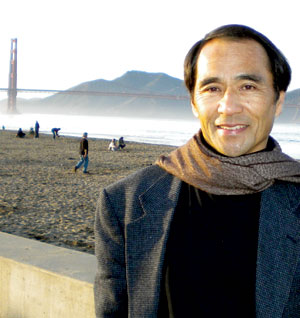Born and raised in San Jose, Sheridan Tatsuno has lived and worked with the poorest and richest people of Silicon Valley. His life story is a combination of opposites. Emerging from working-class Japantown and San Jose High School to becoming one of Silicon Valley’s top strategists since 1983, Tatsuno has consulted some of the most notable zillionaires this valley has known.
Now, he spills the beans, furnishing an e-book of insider tech stories, including his own. In the Valley of Digital Dreams: From Farming to iPad in Silicon Valley should be hitting the e-book markets any week now, so look for it. In the meantime, allow me to equip you with some insider previews.
Tatsuno begins by differentiating the “West Valley’ from the “East Valley.’ The western part of Santa Clara County, he writes, historically encompassed the wealthy Caucasian and now Asian suburbs where everyone goes to college and gets a nice job. This is the heart of Silicon Valley, he says, home to all the giants you know about—Facebook, Google, Apple, Stanford, etc.
However, the eastern half of the county, meaning San Jo, was quite different.
“Rarely told is the East Valley and San Jose,’ Tatsuno writes, “which is heavily populated by working-class ethnic groups who toil as unsung line engineers, janitors, secretaries, shopkeepers and delivery people. These are the people I grew up with who provide the gritty foundation for Silicon Valley’s rise to fame and glory. They are more like John Steinbeck’s Joad family, not Leland Stanford’s heirs.’
What follows is a local, and personal, rags-to-riches Silicon Valley story that could only have evolved as San Jose itself has. Tatsuno paints the scene decades ago, describing with vivid detail the San Jose of 1955, including the lonely four-lane Highway 101 with all of its stoplights and the hick-town airport that people said would never be “international’ because no one would ever want to come here.
He depicts the oceans of vegetable fields surrounding San Jose, the whistles of the fruit-packing canneries, the frogs in the Guadalupe River and the dusty fields where kids played baseball. Decades of car-culture and endless subdivisions had yet to cannibalize suburban America, so in small working-class San Jose, children rode their bikes everywhere. And safely.
“We were the sons and daughters of farmers, farm workers, cannery workers and shopkeepers,’ writes Tatsuno. “Italians, Mexicans, Japanese, Chinese, Blacks, Filipinos, Portuguese, who grew up downtown in simple worker homes down the street from the elegant Victorians of bankers, lawyers and doctors lining avenues of maple trees.’
Tatsuno’s father and grandfather owned Nichi Bei Bussan, a shop in Japantown, the same shop Tatsuno’s sister owns today. Their family helped fellow San Jose High graduate Norman Mineta in his rise to become the first Asian-American mayor of a major U.S. city, in 1971. The Bellarmine World Order had apparently receded from local politics at that time.
But only 25 pages later, as an employee of Dataquest in the ’80s, Tatsuno helps Samsung put together its $5 billion DRAM market entry strategy. He testifies before a paranoid Congress about “Japanese threats’ to the tech industry. He advises Intel on how to ditch its entire memory division in order to focus more on microprocessors. Tatsuno also boldly claims he anticipated technologies that led to Mosaic, Yahoo and YouTube but was unable to convince anyone else.
In telling the story, Tatsuno, who now lives in San Francisco, says above all else, he remains highly indebted and grateful to his father, who refused to leave downtown San Jose and move to the mostly Caucasian suburbs as the city gradually sprawled out and ate the hillsides:
“Years later, we would understand the wisdom of his decision. Many of our minority friends returned to San Jose, Berkeley and San Francisco after growing up in white suburbs, feeling totally alone, ignorant and alienated from their ethnic heritage. They only had white friends, while we had friends of all different colors and backgrounds. We were colorblind, not thinking about a person’s color so much as their character.’
As tech evangelist Guy Kawasaki says in the introduction, Silicon Valley is a place where anything can happen and usually does. Even from the eastern half.




